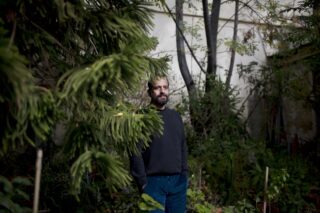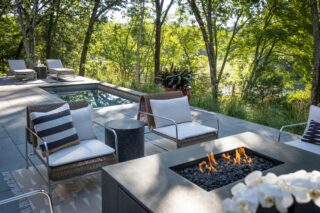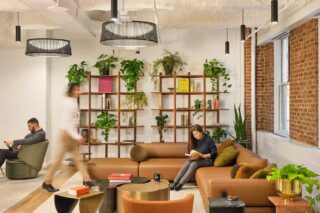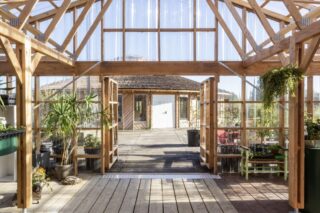Projected for a South African location, this luxury safari will produce its own energy and water.
In 2022, MASK Architects completed the concept of an eco-tourism resort which will be the first in the world to have the capacity to autonomously produce its own water and green (solar) energy. The luxury safari camping experience is to be located in South Africa. The client cannot yet be disclosed, but MASK Architects expects to finish the project – involving the architecture, technology, and the building itself – within the next five years.
Air to Water: Technology to Generate Water
The technology that will allow the BAOBAB Luxury Safari Resort to autonomously produce its own water is called Air to Water. In this system, air filters are placed inside wood-covered aluminum lattice poles that parametrically encircle the facade of each of the multi-modular living lodge structures that form the resort. Then, air and humidity pass through these linear channels and are filtered, condensed, and processed through an additional multi-step filtration system in the system room. The result is healthy, purified drinking water.

”One of the most significant challenges we faced in this project was integrating this water production system into the architecture itself,” Oznur Pinar Çer and Danilo Petta, founders of MASK architects, told ArchiExpo e-Magazine. “Unlike traditional methods where water production technology is centralized in a single location, like a basement, for example, we took a more innovative approach by dispersing this technology throughout different parts of each lodge, splitting it into multiple components and integrating them seamlessly into the building’s structure, from the facade to the roof.”
”This way, every visible element of the BAOBAB living module is not only part of the design but also of a living, functioning machine that produces water for its inhabitants. Our vision is that technology should not just exist within a structure, but be an integral part of its functionality and design, serving the community in the most efficient and sustainable way possible. This approach sets a precedent for how buildings can be designed to work with, rather than against, their natural surroundings.”


Floating above the Trees in Safari Lodges
Raised 3.5 meters above ground level and nestled into the engulfing forest environment, the shelters exude a sense of security and serenity. This feeling of floating high amid the trees echoes MASK Architects’ goal of “diluting” the limits between the safari lodges and the outdoors. The idea is to provide guests with a serene getaway rooted in nature, in which they can reconnect and interact with the wildlife that roams freely in the area.
The BAOBAB Luxury Safari Resort’s beechwood lodges are influenced by the typology of a community settlement and also the shape of the ancient baobab tree – a prehistoric species that predates both mankind and the splitting of the continents over 200 million years ago.
Each lodge has specific areas for luggage and clothing storage, a small bespoke bar for snacks and drinks, an internal bathroom with an enclosed toilet, sink, and shower, a multi-purpose living room, a working area, and a bedroom. The 30m2 swimming pool (with a plunge deck area and an outdoor shower) is integrated into the top floor, from where guests can enjoy panoramic vistas of the safari zone. Along the lower boundary, an interaction balcony allows guests to observe and feed the roaming wildlife – such as giraffes for example. The toughened glass floors of these balconies allow guests to see animals passing below the lodge structure. Around 40 structural pillars support each lodge. The different modules of each structure within each lodge are arranged in such a way as to enable each “block” to be self-sustainable.


Distributing Water to Local Communities
The BAOBAB Luxury Safari Resort is part of a wider restorative scheme intended to create a sustainable and ecological community in South Africa. Some of the water produced by the resort will be distributed to deprived local communities, and tourism will be integrated into the local economy. The resort will be enclosed in a self-sufficient community where it will be possible to grow fruits and vegetables, source water, as well as to farm with animals – and with facilities to produce and sell food such as cheese, bread, meat, and milk.
Pinar Cer and Petta believe architecture has a pivotal role in addressing the urgent challenges of sustainability and climate change.
“We believe that architecture has a profound responsibility not just to deliver amazing designs and meet the needs of the client but also to serve the community and the environment. As architects, we have a responsibility not only to respond to these climate issues but to lead the way in creating innovative solutions that ensure a more sustainable future. Architects should focus more on designing adaptable, resilient spaces in response to changing climate.”
“This includes not only creating energy-efficient buildings but also considering the lifecycle of materials, the carbon footprint of construction, and the ability of a structure to withstand and adapt to climate-related challenges. Alongside the BAOBAB Luxury Safari Resort, we have projects like the H2 BO 85 Hydrogen Yachts, which generate hydrogen fuel onboard, and the Oasys+System, designed to reduce the urban heat island effect. They all reflect our deep commitment to embedding sustainability at the very core of our designs.”











